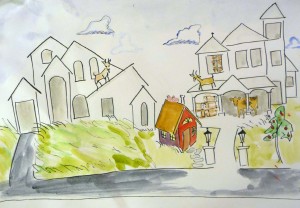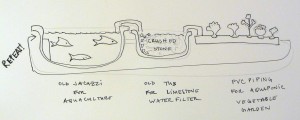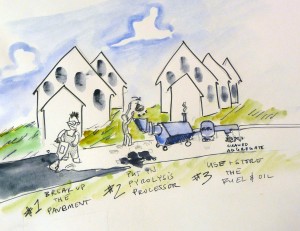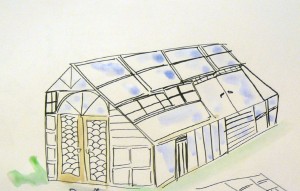Re Burbia Non Finalists Me And Molly
id: 147 title: ‘Re-Burbia non-finalists: Me and Molly’ author: Mathew layout: single guid: https://www.headfullofair.com/?p=147 permalink: /2009/08/25/re-burbia-non-finalists-me-and-molly/ categories:
- post
tags:
- agriculture
header: image: /wp-content/uploads/2009/08/P1050324.jpg teaser: /wp-content/uploads/2009/08/P1050324.jpg
Molly and I only gave the Re-Burbia Competition 4 hours, and Inhabitat/Dwell didn’t like us. That’s ok, we entered because we don’t like them either. Our friends tell us we complain about Dwell too much and architecture competitions ad nauseam. As expected almost all the finalists use stale computer rendered crap images. This project I thought had the right idea (albeit no citations) and good presentation, but like the rest it still depends on infrastructure investments that just ain’t gonna happen. Here’s our entry (I wrote/found citations while Molly illustrated), with extended text intro critiquing suburb resuscitation:
SCRAP THE BURBS
The wreckage of unsustainable industrial neighborhoods are already a new frontier of reduced density within re-awakening urban centers. While the success of urban neighborhood renewal is an attractive image easily transposed to suburbia, urban neighborhoods already have a social and infrastructural fabric to weave back into. The suburbs don’t.
Without cheap transportation, heat and power, people will return to more traditional town/country boundaries that are land, energy, and socially efficient. No development plan will succeed in maintaining the current population density of land cut through with dead-end roads and divided into oversized and poorly sited bedroom houses sitting on 1/4 – 1/2 acre plots. As places like Flint, Michigan have realized, the question is not, “how will we stay here” but rather, “what is this place worth for scrap?”* Suburbia was born in an era of cheap energy, and will die with it.
In the near future abandoned suburban tracts will come up for auction. Confronted with abandoned houses and neglected infrastructure, what resources do suburban homesteaders have, and what can they do with it? Much of the topsoil is of low quality. But intensive and profitable agriculture is definitely possible:
In 2002 a new house had 18 windows** a standard window is 30″x60″ or 225 sq. ft. of window per house
In 2008 94% of new construction had 2+ bathtubs, 28% had 3+***
A 60 gallon bathtub can raise 57 pounds of tilapia****
One cubic meter of asphalt pavement can by pyrolized into 58.4kWh of energy***
The conversion process:
Build a small, solar-cited house with scrap lumber and all your favorite ornamental features. Just enough to get going, and preferably near other homesteaders. You can always expand later.

Pull the windows out of all the houses on the block. Build one amazingly insulated double-pane greenhouse, built over a swimming pool if possible.
Use the pool as a giant fish tank (and thermal mass for the greenhouse) or set up the tubs, sinks and plumbing as a freshwater marine habitat. Crushed concrete may be a substitute for a limestone filter. Useless suburban basements often need pumping to stay dry, use a found pump for water flow. Grow vegetables in aquaponic beds drilled into PVC drainage pipe. Use nearby roofs to collect rainwater. Your greenhouse will provide even with bad/unpredictable weather.

Form a pyrolysis co-op with your fellow homesteaders and tear up unnecessary pavement. Crack it into fuel and drive surplus aquaponic goods to market. Use the money to buy animals and begin grazing nearby land. House them in a converted McMansion barn, and save silage on the second floor.

Graft edible fruit trees onto ornamental trees like cherry and crab apple, if you don’t have any, plant some. Collect and feed acorns to pigs.
Use satellite dish reflectors and abandoned wifi routers to maintain a local network- you need to stay in touch. Enjoy your friends, and don’t plan on getting rich.
*An Effort To Save Flint Mich., by Shrinking It
http://www.nytimes.com/2009/04/22/business/22flint.html
**In 2002 a newly constructed house had an average of 18 windows
http://www.thinkglink.com/article/2002/01/07/what-consumers-are-buying-in-new-construction
*United States Census: Characteristics of New Housing Index- Number of Bathrooms in New One-Family Housees Completed
**http://www.census.gov/const/www/charindex.html#singlecomplete
**250 lb. of fish per cubic meter in small cages
**Oklahoma Cooperative Extension Service SRAC-281, pg. 1
osufacts.okstate.edu
***Energetical Value of Milled Asphalt Bitumen
Solenia New Energy Solutions
solenia.com
